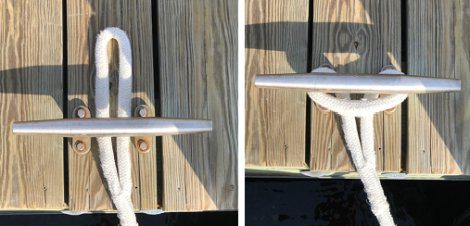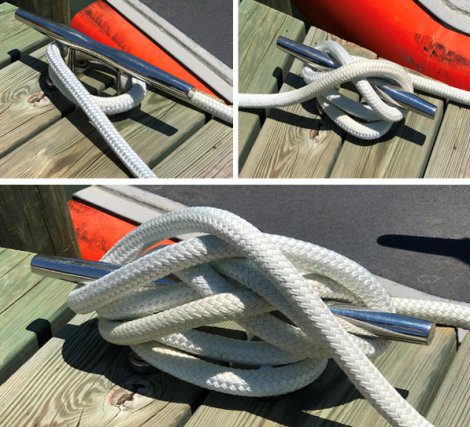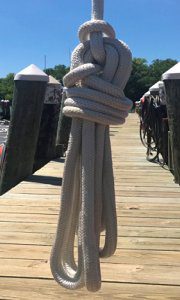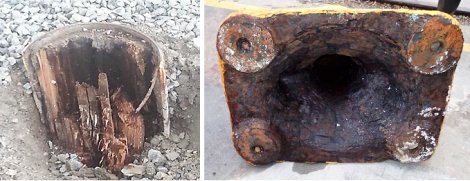 By Bob Currie, Recreational Boating Safety Specialist
By Bob Currie, Recreational Boating Safety Specialist
U. S. Coast Guard Auxiliary Station Galveston Flotilla
One of the frequent types of calls the Coast Guard gets is a report of a vessel with no one aboard. Everyone’s first thoughts is that the boat’s occupants had ended up in the water, and sometimes that is the case. The Coast Guard investigates all such reports, and sometimes the cause of a boat being unoccupied is because it escaped its moorings. We have a couple of wrecks in our area from recent incidents where a boat escaped its moorings, went way out to sea, and was eventually pushed toward land and broke up in the surf. This column will discuss the most common causes of boats getting underway unexpectedly.
The Station Galveston Flotilla of the US Coast Guard Auxiliary operates out of the USCG Station Galveston base on Galveston Island. They aid the Coast Guard by providing maritime observation patrols in Galveston Bay; by providing recreational boating vessel safety checks; and by working alongside Coast Guard members in maritime accident investigation, small boat training, providing a safety zone, Aids to Navigation verification, in the galley, on the Coast Guard Drone Team and watch standing.
Cause One: Improper Securement
Often the cause of a boat slipping its mooring is due to improper securement. That means someone didn’t use proper mooring technique in the first place. Their boat simply pulled the dock lines loose and bounced around in the anchorage for a while, banging other boats and the dock, doing damage to the loose boat as well as properly secured boats nearby. Wave and tide action can really test your mooring skills. Bad knots, not enough lines, lines too tight, lines too loose, all can cause your boat to slip its mooring. Here are some hints to help you make sure your boat is properly secured.
Securing a Dock Line to a Cleat Using the Eye
The standard dock line is usually 25 feet long and has an eye in one end. The eye is used to secure the line to a cleat. Although the pictures show securing the dock line to a dock cleat, I find it more useful to tie the dock line to a boat cleat before approaching the dock, and then you need only to secure the line to a cleat on the dock or use the dock line to make a turn around a dock pole and secure the line back to the boat cleat. The latter method makes it much easier to cast off from the dock.

Securing a Line to a Cleat Using the Free End
This is the method used to secure a line to a dock cleat when mooring. That means you plan to be there a while. Note that a full turn is made around the bottom of the cleat prior to making three figure eights on the cleat. It is not necessary to make a final locking figure eight when a full round turn is first made. A locking figure 8 can make it very difficult to remove the line from the cleat due to tightening by wave and tide action.

Cause Two: Broken Mooring Lines
Mooring lines have life spans that can be shortened due to exposure to the elements, being overstressed due to tide and wave action, and by being too small a diameter or the wrong type of line for the job. It also doesn’t help when you have boat operators who violate the No Wake Zone and create destructive waves. Your best defense against such inconsiderate operators is to use sufficient bumpers as well as sufficient lines to keep your boat from breaking loose from the slip due to broken mooring lines. Remember also that dock lines don’t last forever, and they will fail sooner if you do not take care of them.
Line Inspection
Lines should be periodically inspected for the following:
- Signs of aging (discoloration, brittleness)
- Fraying
- Kinks
- Overloading (loss of stretchiness)
- Foreign material (salt buildup, mold, sand, dirt, paint chips)
If any lines show signs of degradation they should be replaced and not used.
Line Maintenance
Lines can degrade with prolonged exposure to salt water and UV light. As the water dries out it leaves sharp grains of salt which can accelerate line fraying and reduce line strength quickly unless the line is well-rinsed with fresh water and dried before it is stored.  Keeping your lines clean and drying them before storing them will prolong their life. Try to tie knots in different places so as to not wear out the line. Loosen taut lines when they become wet as lines shrink when wet. This will help prevent line overloading.
Keeping your lines clean and drying them before storing them will prolong their life. Try to tie knots in different places so as to not wear out the line. Loosen taut lines when they become wet as lines shrink when wet. This will help prevent line overloading.
Stowing Lines
Lines should be stowed to prevent or lessen exposure to harmful chemicals, salt water, and UV rays from the sun. Synthetic line should not be coiled in the same direction, as doiong this tends to tighten the line twist. Instead, it can be coiled in figure eights to avoid kinks when paying out (see picture below).
Cause Three: Broken Moorings
Recently there have been some shoreside marine piling and bollard failures that have cast moored vessels adrift. In one instance a Coast Guard Fast Response Cutter was cast adrift due to bollard failures during a very strong windstorm. The cutter beat itself against the concrete pier until it broke completely loose and severely damaged a Coast Guard construction tender. Yes, heavy cast iron and steel bollards are subject to quick (relatively speaking) deterioration in heavy salt environments. Piling failures are also common.

Make sure that piling you are about to tie off to isn’t rotted or the dockside cleat isn’t loose or rusted, especially if you expect to leave your boat tied to the dock for a while. There is a sailing yacht lying on its side on a sandbar in Offatt’s Bayou off Galveston Island. It broke loose from its mooring. A motor sailboat that washed up on the beach near Rollover pass was a live aboard that broke loose from its moorings and floated around in the gulf for months before the tide pushed it near shore. It still had clothes hanging from a clothesline and a motorcycle on the front deck before being broken up in the surf.
The Coast Guard strongly recommends that marina owners and operators develop a routine inspection program for bollards and other mooring equipment. Vessel operators should report discoveries of apparently deficient shoreside mooring equipment to marina managers.
[Apr-19-2022]

 Posted in
Posted in 























